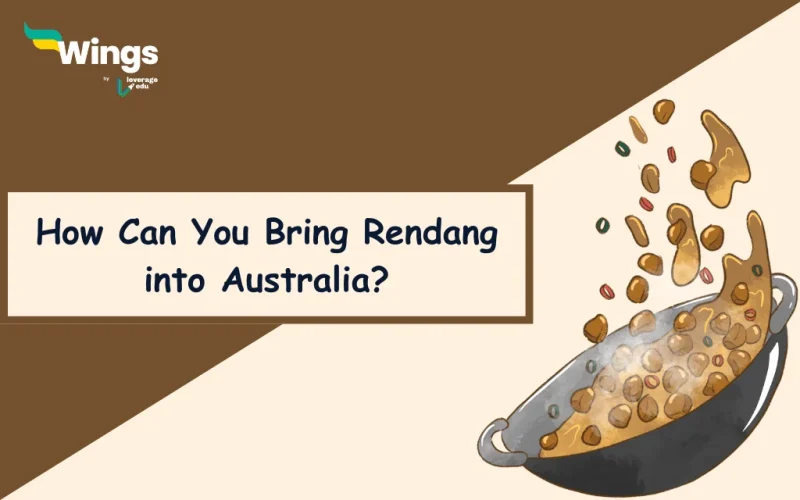For many international students, the thought of missing home-cooked meals and familiar snacks can be a challenge when studying abroad. Bring rendang into Australia for Indian students, in particular, may find themselves longing for traditional foods like chips, sambal, instant noodles, instant cooking spices, and rendang. While these foods are an integral part of their culture and daily life, bringing them to Australia requires careful consideration due to the country’s strict agricultural policies.
This Blog Includes:
Bringing Rendang into Australia
Australia, known for its vast agricultural industry, enforces regulations to protect its environment and prevent the introduction of foreign pests and diseases. These regulations are essential in ensuring that Australia’s biosecurity is maintained, safeguarding its unique flora, fauna, and agricultural practices. For Indian students hoping to bring rendang or other traditional foods into the country, it’s important to understand the specific guidelines that must be followed.
When packing food items for travel to Australia, students must declare any food products at customs, including rendang, as it falls under the category of meat-based dishes. Certain meat products are subject to restrictions or may require inspection upon arrival. To avoid any issues or delays, students should check the Australian Government’s Department of Agriculture and Fisheries website for the most up-to-date rules and procedures. By adhering to these guidelines, students can enjoy their favorite foods while staying compliant with Australia’s biosecurity regulations.
What Are Rendang Items?
Rendang is a traditional Indian dish that is both beloved and versatile. It typically consists of the following key items or ingredients:
- Meat
- Coconut Milk
- Species
- Chilers
- Dry Species and Fruits
- Seasoning
Know about the Cost of Living in Australia: Updated Prices
Can You Bring Rendang into Australia
When bringing rending into Australia, it’s important to adhere to the country’s strict government rules and regulations regarding food imports. The type of rending you are bringing determines the specific guidelines you must follow.
- Homemade Rending is often subject to additional scrutiny. This includes ensuring it is properly sealed and free from contamination. You may need to provide detailed information about its ingredients and preparation process for approval.
- Commercially Packed Rending typically requires inspection for compliance with Australian food safety standards. Packaging must be intact, and the product should be properly labeled according to local regulations.
- Canned and Processed Rending is subject to specific packaging requirements to prevent the spread of pests or diseases. Ensure that the cans are tightly sealed and meet Australian standards for food safety. Each type of rending will be assessed based on these regulations before it is allowed entry.
Know about the average Cost of Living in Canberra: A Comprehensive Guide
What Can You Bring To Australia?
According to biosecurity, the law allows certain items to be brought into the country, you need to meet the provided guidelines. Here are examples of some items you may bring to Australia:
| Package Food | Commercially packaged snacks such as biscuits, chocolates, and chips. Canned food, including soup, vegetables, and meats, if they are factory-sealed and shelf-stable. |
| Dried and Preserved food | Dried fruits, herbs, and species, preserved vacuum-sealed food like jams, honey |
| Meat and Dairy | Some meat and dairy products may be allowed if they are commercially processed and sealed. |
| Plant Based Items | Tea and coffee commercial packaging, wooden and plant-based products. Commercial packaging and labelling with the complete botanical name are required for seeds. |
All About the Best Restaurants Near University of Sydney
FAQs
For individual use, commercially made and packaged sauces (such as ketchup/catsup, soy, chilli, and peanut sauce) and curry pastes are permitted in Australia.
Generally speaking, you cannot bring meals, pastries, or anything you produced yourself. Press Enter to display additional information. Cakes, pastries, biscuits, bread, Christmas cake, and Christmas pudding (but not cheesecakes) Drinks and food.
Fresh produce, meat, chicken, pig, eggs, dairy goods, live plants, and seeds are all prohibited in Australia. These goods have the potential to ruin Australia’s special ecology by bringing dangerous diseases and pests here.
This was all about How Can You Bring Rendang into Australia. If you want to know about Australian culture follow Leverage Edu.
Related Reads
 One app for all your study abroad needs
One app for all your study abroad needs















 60,000+ students trusted us with their dreams. Take the first step today!
60,000+ students trusted us with their dreams. Take the first step today!